|
|
Fake and
Reproduction RR Lanterns: Alterations
The most common and insidious type of fake lantern frame involves altering
an existing frame, usually by adding markings of a rare railroad. Since
railroad markings are one of the most important factors in determining
value, this counterfeiting method is a serious problem for collectors.
The best defense here is careful inspection of lettering. The original
manufacturers used dies to emboss lantern frames, and generally the lettering
was evenly done and consistent in style from lantern to lantern. Unfortunately,
some of these original dies are rumored to have been used to produce
fake markings, so clean lettering is not an automatic indicator of authenticity.
Generally, collectors are advised to inspect embossed lettering for:
- unevenness and crude workmanship;
- breaks in the surface plating or "tin" possibly indicating
that the lettering was done later than when the frame was produced;
- differences in lettering style ("font" type or size)
compared to other examples of lettering from the same manufacturer.
Note that it is fairly common from the embossed or stamped letters to
have holes or tiny perforations through the surface of the lid, either
through corrosion or a strong original strike by the manufacturer, so
this in itself is not a cause for concern.
In addition to embossing, there are instances of tags soldered to the
lids of lanterns to suggest identification with a particular railroad.
Some of these tags are known to be authentic -- a few railroads, particularly
short lines, actually did this in lieu of embossing -- so tagged lanterns
cannot be automatically considered fakes.
The following information on known or suspected lantern alterations
has been obtained from various sources judged to be knowledgeable and
accurate. The information is presented with "honest intentions";
however we cannot guarantee complete accuracy, so please use this information
as advisory only -- see Disclaimer.
 Fake
L&HR RR (not "RY") markings on Dietz Vesta lanterns
were done about 15 to 20 years ago and still show up in the market,
including Internet auction sites. The markings are slightly smaller
than those seen on authentic Dietz lantern markings. The consensus
among L&HR experts is that all authentic Vestas from this railroad
were marked as "L&HR Ry". Also a reported tipoff
is that some of the fakes have a barely visible frame around the
marking, although this may not necessarily be present on all the
fakes. In addition to the characteristics noted above, the lettering
is rather uneven and has the appearance that the letters were done
with individual dies one at a time. Fake
L&HR RR (not "RY") markings on Dietz Vesta lanterns
were done about 15 to 20 years ago and still show up in the market,
including Internet auction sites. The markings are slightly smaller
than those seen on authentic Dietz lantern markings. The consensus
among L&HR experts is that all authentic Vestas from this railroad
were marked as "L&HR Ry". Also a reported tipoff
is that some of the fakes have a barely visible frame around the
marking, although this may not necessarily be present on all the
fakes. In addition to the characteristics noted above, the lettering
is rather uneven and has the appearance that the letters were done
with individual dies one at a time.
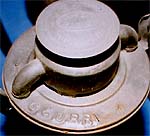  Another
known Vesta Fake is one marked "G. & U. R.R." According
to Tom Stranko, "Note the poor definition on the letters.
The style and size of letter is not correct for a Vesta but is
so Another
known Vesta Fake is one marked "G. & U. R.R." According
to Tom Stranko, "Note the poor definition on the letters.
The style and size of letter is not correct for a Vesta but is
so 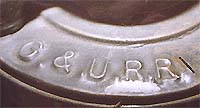 close
as to pose a difficult challenge unless you really LOOK at the
stamping. Letters appear to be RR Signal Lamp & Lantern Co.
style." close
as to pose a difficult challenge unless you really LOOK at the
stamping. Letters appear to be RR Signal Lamp & Lantern Co.
style."
|
  At
one time fakes such as this were being made in western NY. They
were all done on typical unmarked brass top, bell-bottom lantern
frames (mainly older Parmelee & Bonnell). They also displayed
signs of having been dismantled and reassembled. The lettering
style is small, almost like that of the RR Signal Lamp & Lantern
company but a bit larger. The sample shown upper right is marked "D
A V & P RY" and had been in a fire. At
one time fakes such as this were being made in western NY. They
were all done on typical unmarked brass top, bell-bottom lantern
frames (mainly older Parmelee & Bonnell). They also displayed
signs of having been dismantled and reassembled. The lettering
style is small, almost like that of the RR Signal Lamp & Lantern
company but a bit larger. The sample shown upper right is marked "D
A V & P RY" and had been in a fire.
|
 A&W
250 lanterns have shown up with the following fake markings: Sierra
RR, T&T RR, N.N. RR, V&T RR. The best guess is that
these are being done with a real A&W die set, since they appear
to be very authentic. A&W
250 lanterns have shown up with the following fake markings: Sierra
RR, T&T RR, N.N. RR, V&T RR. The best guess is that
these are being done with a real A&W die set, since they appear
to be very authentic.
|
 Questionable
Lettering. In a "grayer area" are judgments about
authenticity based on lettering that is well-done but very unusual
for the particular manufacturer. Among veteran lantern collectors,
it is known that there have been a few individuals over the years
who have produced counterfeit markings of high quality on lantern
frames that were originally unmarked. The original lantern manufacturers
produced a fairly large number of such unmarked frames for the
generic market, so there is a lot of material available, even
today, for this practice. How much counterfeit marking is going
on currently is not known, but undoubtedly examples of this practice
can still show up in today's collector's market. Questionable
Lettering. In a "grayer area" are judgments about
authenticity based on lettering that is well-done but very unusual
for the particular manufacturer. Among veteran lantern collectors,
it is known that there have been a few individuals over the years
who have produced counterfeit markings of high quality on lantern
frames that were originally unmarked. The original lantern manufacturers
produced a fairly large number of such unmarked frames for the
generic market, so there is a lot of material available, even
today, for this practice. How much counterfeit marking is going
on currently is not known, but undoubtedly examples of this practice
can still show up in today's collector's market.
To identify counterfeit markings, one approach is to compare
lettering or "font" sizes and styles with known authentic
examples. This approach is somewhat risky since the original
lantern manufacturers were not necessarily completely standardized
in their tooling, and it is also known that a fair amount of
subcontracting occurred among manufacturers. Nevertheless, unusual
lettering is a warning that something may not be right, and collectors
are advised to beware, particularly with "big ticket" items.
Shown here, courtesy of Tom Stranko, are some examples of questionable
lettering. Upper Right. A fake Keystone "Casey" stamped
(very nicely) using old style Adams & Westlake dies. Middle
Right. A C.T. Ham lantern whose stamping dies were 1/2" tall
and 3/8" or more wide. These tiny letters are totally atypical
for this manufacturer. Far Lower right. An R.E. Dietz "Steelclad" lantern
with lettering that is totally wrong for Dietz. |
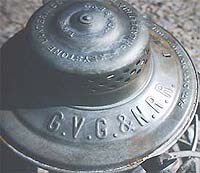 |
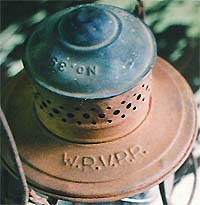 |
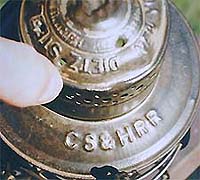 |
 Modified
A&W Kero. The
following was sent in by a collector regarding a modified (faked) A&W
Kero. "I bought recently at an auction
a Texas and New Orleans short globe Adlake Kero lantern. I bought
the lantern for the etched red short globe and paid accordingly. The
lantern pot was stamped 3-41 so the age was correct. I was suspicious
that the top had been faked because the T&NO lettering was straight
across, was also not correct for an adlake lantern of that vintage. The
top latch was also of post 1960 construction, the top actually read
Adlake Kero, and the top appeared to have been soldered on to the hinge. When
I got the lantern home, it was obvious that the lettering had
been applied later, but aged on the outside of the top to look old. There
was also an aged solder spot in the top of the lantern, which covered
up a PC mating worms logo. So it appears
that even short globe lanterns are not safe from fakes. In my
case I was lucky because I bought the lantern for the globe, and it
fits my 250 kero just fine." Modified
A&W Kero. The
following was sent in by a collector regarding a modified (faked) A&W
Kero. "I bought recently at an auction
a Texas and New Orleans short globe Adlake Kero lantern. I bought
the lantern for the etched red short globe and paid accordingly. The
lantern pot was stamped 3-41 so the age was correct. I was suspicious
that the top had been faked because the T&NO lettering was straight
across, was also not correct for an adlake lantern of that vintage. The
top latch was also of post 1960 construction, the top actually read
Adlake Kero, and the top appeared to have been soldered on to the hinge. When
I got the lantern home, it was obvious that the lettering had
been applied later, but aged on the outside of the top to look old. There
was also an aged solder spot in the top of the lantern, which covered
up a PC mating worms logo. So it appears
that even short globe lanterns are not safe from fakes. In my
case I was lucky because I bought the lantern for the globe, and it
fits my 250 kero just fine."
Additional Comments:
Scott Czaja, noted authority on early New England and fixed-globe lanterns,
was asked to comment on fake, fixed globe lanterns and suggested that
things to watch out for are (1) whether the plaster
is all original, (2) whether there are any vertical
mold seams (indicating the globe was made later), and (3) similarity
to known, legitimate examples (although this is tricky because there
were many little glass companies all over New England and therefore many
differences in style.) Scott also indicated, "There seems to be "cut
fixed globe" phobia
in the hobby. I always want to
know WHO says it's no good and, more important, WHY
they
think that it is no good. Yes, there were fakes made in New England going
back 12-20 years ago. Many are not hard to spot for many reasons. Others
are
very good."
Other comment: "Just a note that your
discussion does not take into consideration that a production line
must periodically retool. The run time of the Vesta lamp alone
would suggest the possibility of slight variations in the letters over
the entire period. Along
that line of reasoning, assuming the lids were stamped on two production
lines it is also not unlikely that the two lines would have slight
variations in the dies at the same period. I appreciate the concern
as much as any of us, yet I believe you are missing opportunities
by being overly suspicious of variations. Styles do and did change. Should
not a more critical criteria be the fit and alignment of the stamping
to the place allowed for it? And even here I have seen variations
on the same railroad that in your analysis would be "fake" when I know
by source it is correct. Am I correct that the manufacturer's
applied road initials are not "stamped" into the metal as has been
suggested but are rather "pressed" into it? The result is quite
different and not easily faked on old and cold metal. Some
of the examples shown would have fooled me (I've only seen the photos) on
several. I
can't imagine anyone successfully stamping that old metal, must less
removing the lids and pressing it.
Years ago, 1973 or thereabouts, while touring the Maine Central
Shops at Waterville Maine I noticed in their tin shop that their craftsman
performed the functions of repairing lanterns. Rather than throw away
a lantern they restored them and put them back out and/or actually
made them. How long
before my visit that work had ceased in that portion of the complex I
do not
know. It must have been years though, the dust was thick, and as I recall,
work in progress was left right on the bench when the workers moved on. -
Paul Larner 2/06
Thanks to Dave H., Roger Schmorr, Ted Douthitt, John Brainard, Paul
Larner, and especially Tom Stranko |